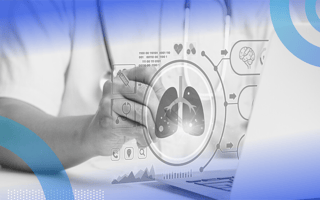Lung cancer is the leading cause of death by cancer in the world. Experts estimate that 234,580 people will be diagnosed with lung cancer this year in the United States alone, and that one in 16 men and one in 17 women will be diagnosed with lung cancer in their lifetime.
One promising advancement in cancer screening is fragmentomics AI. This technology uses AI to analyze cell-free DNA, or cfDNA, fragments circulating in the blood.
CfDNA fragments are small pieces of DNA released into the bloodstream by dying cells. In cancer patients, these fragments, often originating from tumor cells, serve as valuable biomarkers for detecting malignancies.
Here, we delve into the intricacies of lung cancer screening using fragmentomics AI, its potential benefits and challenges and the outlook for this technology.
What Percent of People Get Screened for Lung Cancer?
Fewer than 5 percent of people eligible for a lung cancer screening in the United States receive the current standard screening, which is a low-dose computed tomography scan. Whether this is due to inaccessible screening methods or a lack of awareness, this poses a severe challenge in detecting cancer early when it’s most treatable.
How Fragmentomics AI Works
Conventional cancer screening methods such as imaging and biopsies can be invasive, expensive and sometimes inadequate for early detection.
With fragmentomics AI, the process begins with a simple blood draw from the patient, from which medical professionals extract cfDNA.
AI algorithms then analyze the cfDNA using machine learning models trained on vast data sets of cfDNA profiles from patients diagnosed with cancer and those at high risk of developing lung cancer. High-risk individuals are typically 50 years or older with a smoking history, according to the USPSTF guidelines for lung cancer screening.
The hallmark of fragmentomics for cancer screening is that circulating tumor DNA, or ctDNA, is shorter than the background non-tumor DNA. Using the variation in DNA packaging across different cell types, we can detect fragmentation patterns associated with lung cancer.
Challenges of AI Cancer Detection
Despite its potential, next-generation blood testing for cancerous tumors with AI faces several challenges. Some are unique and some are general to the screening and/or diagnostics space.
Data Complexity
The assays (lab tests and experiments) produce a lot of data. Large data sets and sophisticated algorithms are required to model disease spectrum in people with and without cancer, and to incorporate the biological variability in these individuals.
Multiple complementary assays may be necessary, because tumors are diverse and shed differently at different disease stages and in different tissues.
Bias in Clinical Trials
Medical professionals carefully design clinical trial enrollments to avoid sources of artifacts and bias — in this case, bias means ensuring the training data represents the subgroups evenly.
Predicting the performance of a machine learning model on a larger scale, however, remains challenging due to its complexity. Well-designed trials and algorithmically handling the unequal distribution of variables in a data set can mitigate sources of bias.
Model Performance
Results produced in a model that doctors send to patients must be accurate and reproducible to avoid unnecessary anxiety and invasive procedures while also catching early cancers.
Medical professionals usually use an independent, concealed clinical validation set to assess a model’s performance. This minimizes the risk of overfitting and maximizes the applicability of summary performance metrics to the intended use population.
Although these aggregate metrics are extremely important for how a model performs on unseen patients, the model must not miss obvious cancer cases, such as late stage cancer.
Regulatory Implications
The regulatory environment for diagnostics is evolving. For example, the FDA recently classified lab-developed tests as in vitro diagnostic products. As a result, companies that market LDTs will have to respond, forcing many companies to re-validate their lab developed tests again, which is time consuming and costly.
A Fragmentomics AI Product in the Works
The biotechnology company where I work has launched several clinical trials to demonstrate the performance and utility of fragmentation, including L101 (NCT04825834) and CASCADE-LUNG (NCT05306288). We collected high-quality data from a prospective trial, which provides the large data set necessary to train a robust algorithm.
The first fragmentation-based product developed by DELFI Diagnostics is FirstLook Lung, which provides a non-invasive, sensitive alternative with high negative predictive value. It analyzes the size, distribution and sequence patterns of cfDNA fragments to identify lung cancer.
The FirstLook Lung test is a laboratory-developed test. DELFI Diagnostics developed it and determined its performance characteristics. It has not been cleared or approved by the FDA. The laboratory is regulated under the Clinical Laboratory Improvement Act as qualified to perform high-complexity clinical tests.
An Optimistic Future for AI in Cancer Screening
The future of cancer screening using fragmentomics AI is promising. Research and development are ongoing to overcome current challenges.
Integration with other diagnostic modalities could enhance the accuracy and reliability of cancer detection, and high throughput assays can reduce healthcare costs in the long run by avoiding late-stage cancer treatments.
Advancements in AI algorithms and more publicly available data sets will continue to improve the sensitivity and specificity of fragmentomics-based screening.





